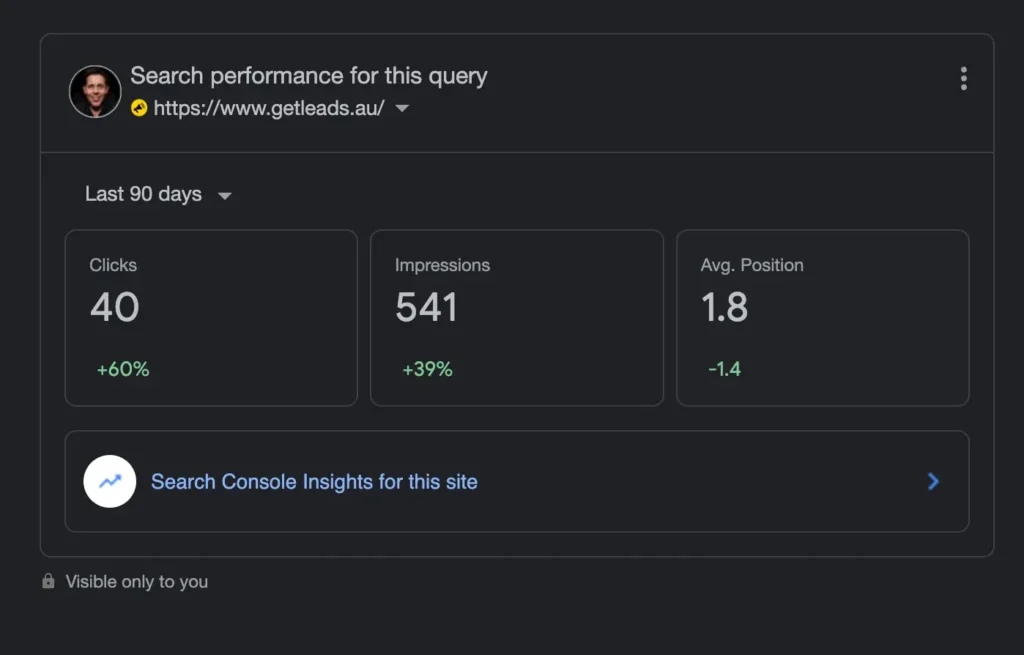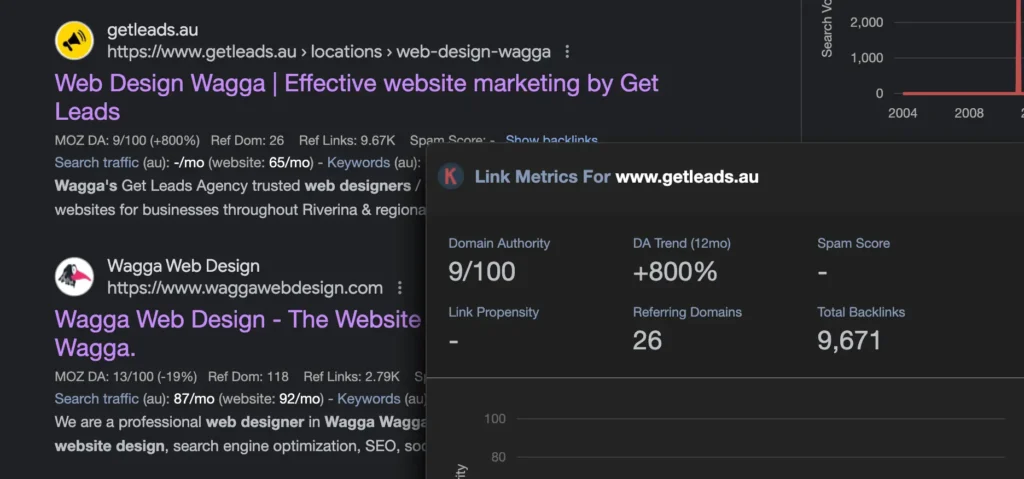What does your website analytics data really mean?
Happy October readers, you might be tempted to build a website and blindly hope for the best or maybe you’ve just paid to get one redone. You may even find yourself on page 3 after clicking through countless others on Google but hopefully not if you’re a Get Leads customer.
Do you want to be that business or do you want to be number 1 for the keywords you know people are searching for. The answer seems obvious but most people don’t even know how many visitors they have to their online presence every month.
Website analytics can be a confusing beast at the best of times.
You’ve likely set up Google Analytics or a privacy-focused analytics tool like Fathom to enable your team to track your website’s performance. At Get Leads all of our websites have been setup with Google Analytics and so if you’re a customer these numbers are ticking over in the background and I’m more than happy to add access for you if you don’t already have it.
When you start looking at your analytics data, you may not understand what everything means. If that’s you, don’t worry — this is a normal feeling. Most business owners aren’t data scientists with years of expertise in analytics or SEO. Here’s my link to our SEO services if traffic is that one metric you just can’t seem to get going. I’ll also have some pretty awesome case studies available soon from some work I’ve been doing ongoing with a plumber in Melbourne. He’s absolutely killed the competition to the point he’s had to put on more staff. 12 Months ago he was on the decline.
Explaining website analytics data metrics
The good news is that understanding your website analytics is much easier than you might imagine.
I’m going to run through some key data points to look out for in your analytics data. I’ll explain each data point and why you’ll want to track it.
By the end of this blog post, you’ll be armed with everything you need to start turning your analytics data into powerful metrics that can help your business.
- Traffic – Your website traffic data shows how many people visit your website daily. You’ll also be able to see how visitors found your website. For example, they could find your website through a search engine, click on a link on social media, or click through via a paid ad. Understanding how people reach your website helps you to evaluate the performance of your marketing efforts. Every month we send out to all our WordPress based customers some raw traffic numbers through our reporting system which is included in their website management plans. If this isn’t you, you can always login to Google Analytics and find these numbers manually.
- Top Performing Pages – Your top-performing pages typically receive the most traffic and conversions. You can see which pages get the most visitors using your analytics data. This is crucial for your business, as you can see which content your audience enjoys the most, allowing you to create more of it. For us our Wagga based location page is one of our number one’s instead of our homepage because it’s easier to rank a page with more Wagga context than it is to rank a homepage with a few mentions of the the city. This is especially true because around 160 people search for “Web Design Wagga” every month although I’m convinced 80% of these are other agencies. Hot tip: If you look through your previously high performing pages and can see one in particular has done really well
- Average Session Duration – A visitor’s total time on your website in one visit is known as a session. The average session duration lets you know how long the average visitor spends on your site. The longer visitors stay, the more engaging or exciting they likely find your content. If your session duration is low, this provides a big clue that your content may need updating. It could also be that you’re getting lots of robots otherwise known as bots visit your page and then leave straight away after maybe harvesting your email from the copy. (We never put email addresses on websites for this reason and unless you want SPAM you shouldn’t either)
- Bounce Rate – The bounce rate metric can be very helpful, as it shows the percentage of visitors who leave after only viewing one page. Average bounce rates can vary depending on the industry or target audience. A good rule of thumb would be to expect a bounce rate of around 40%. If your bounce rate is considerably higher than this, you may need to work on making your website content more engaging to visitors.
- Conversion Rate – When you’re serious about generating leads or sales through your website, your conversion rate is the most important metric to track. It tells you the percentage of visitors who take a desired action, such as purchasing a product or service, completing a contact form, or signing up for your email newsletter. Increasing your conversion rate means more leads or sales for your business. Conversion rate goals can be setup on any analytics platform to measure the amount of success you have. This might simply involve identifying the page or URL that appears after someone submits a contact form.
- Page Load Time – To the disgust of every web designer using SquareSpace a slow website can have a big impact on your business’s success. Page load time measures how quickly your web pages load for visitors. Slow-loading pages can easily frustrate users and lead to higher bounce rates. Faster load times can bring more leads or sales and can even impact your search engine visibility.
- New vs. Returning Visitors – Striking a balance between first-time and new visitors shows that you’re successfully attracting new potential customers and building loyalty with existing ones. If you find the metric skews in one direction, you either need to improve your marketing or work on encouraging existing customers to return to your website regularly.
Final thoughts on search intent as it relates to analytics
One final comment about keyword rankings, these aren’t the only thing to consider. Your competitor might rank higher than you but sadly his/her site may not be what that customer is looking for so they find you at position 2. The “Search Intent” Google matchmaker is sometimes slightly off. Try to rank in the top 3 for the keywords you know customers are using unfortunately depending on the keyword this may even be something that’s just not possible. Sorry, you’re just not going to rank top 3 for “Accommodation Wagga” after airbnb and bookings.com. Know you’re searches intent and know what SERP mix Google are likely to use with a specific target keyword. What I mean by this is out of the top 10 how many small to medium business listings are there actually ranking.
More Data – Google Search Console
As a geek, there’s one thing I love and that’s data and reporting. Anyone can go into Google Search Console if they have access to their domain and visit the “Search Results” menu item to see what keywords your showing up for and how many clicks and impressions you’ve received from this keyword.

If you click through the keyword you can also see what pages are responsible for traffic, you can go back 6 months see if it’s the same pages are still getting traffic. You can then build on your past work through updates or internal links to it from new articles and you’ll see results.
Google Embedded Search Console
One other handy widget that appears on your search listings if you’re logged in with the user account that has Google Search Console will show you your average rankings and looks a little like this:

For me I saw these two articles performing really well 12 months ago:
- Planning out a website takes just as long as building it
- The benefits of hiring a Professional Web Designer in Wagga
Let’s see where this article takes us in two to three days. If it doesn’t work then guess what? I’ll be back next week with another article and then another.
Google Core Search Updates
Another thing to note is you can find out when the latest update to the search Algorithm was and what the focus was here to try to capitalise on the opportunity but if there’s nothing happening with new updates and you’ve been knocked off your long term no.1 ranking then perhaps your competitors have some SEO work that’s going on. Here’s a link to where you can find out about the latest Core updates. If you don’t want the extra email SPAM you can also add this to the feed reader I mention later in this article. https://searchenginejournal.com/feed
Keeping an eye on you’re competitors SEO
There’s lots of ways this can happen from paid services with expensive SEO tools like AHREFs to monitor your keyword rankings or even better “Keywords Everywhere” which is quite affordable at around $10 AUD per month and provides you results right from your browser search. From here you can monitor any backlinks or keywords for your competitors, just note that the data is quite slow to update so checking the day after your rankings has been bumped will probably not tell you much.

Content is super important for any website and as you can see with my blog and insights their’s always articles centred around specific themes. You can search for your competitor and if they’re using a content strategy that involves a blog, why not add the feed from their site to an alert widget on your browser so you’re made aware of their latest strategies. One I use is called RSS Feed Reader which simply just needs you to add the word “feed” after a URL and you’ll be updated when new content has been added. eg. getleads.au/feed
I’ve written a few articles to date on SEO tools and in order to re-establish my authority in this content area:
Don’t be too quick to check Google for results
So many customers will ask me the day after their new site is launched why they’re not on Google. It takes time but to speed things up you can login to Google Search Tools and submit the new article or content manually to make Google aware. I would then give it 24-48 hours before something happens.
Signing off
Have a great start to October, if you need help with anything above please pop me an email and I’ll be more than happy to share some knowledge that will get you on the path to where you want to be.
I’ll check back in later in this month with some updates on our Google Ads campaign as well as our Instagram campaign that is also about to start in the next couple of week.






